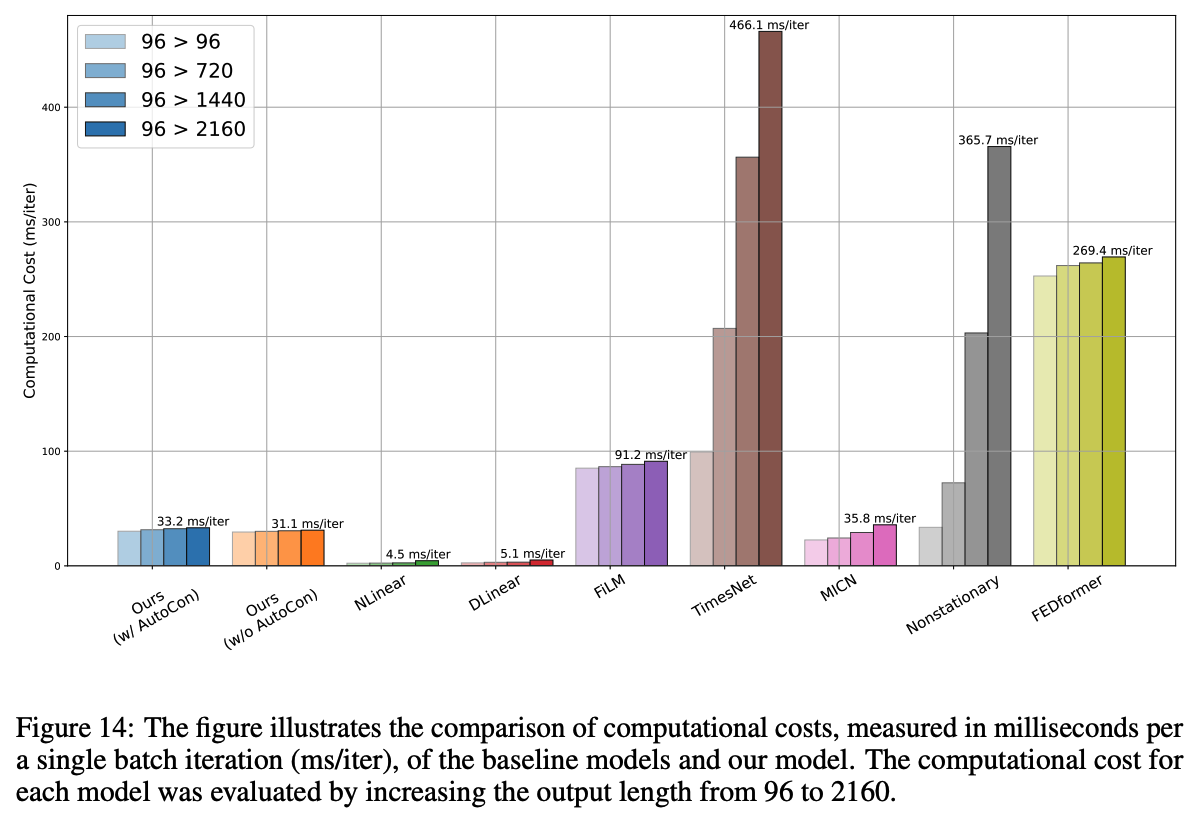Self-supervised Contrastive Forecasting
https://openreview.net/pdf?id=nBCuRzjqK7
Contents
- Abstract
- Introduction
- Related Work
- Method
- Experiments
Abstract
Challenges of Long-term forecasting
-
Time and memory complexity of handling long sequences
-
Existing methods
-
Rely on sliding windows to process long sequences
\(\rightarrow\) Struggle to effectively capture long-term variations
( \(\because\) Partially caught within the short window )
-
Self-supervised Contrastive Forecasting
-
Overcomes this limitation by employing…
- (1) contrastive learning
- (2) enhanced decomposition architecture
( specifically designed to focus on long-term variations )
[1] Proposed contrastive loss
- Incorporates global autocorrelation held in the whole TS
- facilitates the construction of positive and negative pairs in a self-supervised manner.
[2] Decomposition networks
https://github.com/junwoopark92/Self-Supervised-Contrastive-Forecsating.
1. Introduction
Sliding window approach
- enables models to not only process the long-time series
- but also capture local dependencies between the past and future sequence within the windows,
\(\rightarrow\) Accurate short-term predictions
a) Transformer & CNN
- [1] Transformer-based models
- Reduced computational costs of using long windows
- [2] CNN-based models
- Applied a dilation in convolution operations to learn more distant dependencies while benefiting from their efficient computational cost.
\(\rightarrow\) Effectiveness in long-term forecasting remains uncertain
b) Findings
Analyze the limitations of existing models trained with sub-sequences (i.e., based on sliding windows) for long-term forecasting tasks.
-
Observed that most TS often contain long-term variations with periods longer than conventional window lengths …. [Figure 1, 5]
-
If a model successfully captures these long-term variations. ….
\(\rightarrow\) Representations of two distant yet correlated windows to be more similar than uncorrelated ones
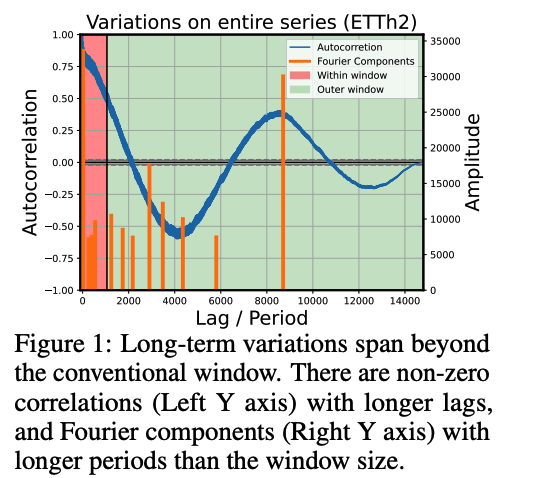

c) Limitation of previous works
-
Treat each window independently during training
\(\rightarrow\) Challenging for the model to capture such long-term variations across distinct windows
-
[Figure 2]
- Fail to reflect the long-term correlations between two distant windows
- Overlook long-term variations by focusing more on learning short-term variations within the window

d) Previous works
[1] Decomposition approaches (Zeng et al., 2023; Wang et al., 2023)
- Often treat the long-term variations partially caught in the window as simple non-periodic trends and employ a linear model to extend the past trend into the prediction.
[2] Window-unit normalization methods (Kim et al., 2021; Zeng et al., 2023)
-
Hinder long-term prediction by normalizing numerically significant values (e.g., maximum, minimum, domain-specific values in the past) that may have a long-term impact on the TS
-
But still …. normalization methods are essential for mitigating distribution shift
\(\rightarrow\) *New approach is necessary to learn long-term variations while still keeping the normalization methods
e) Proposal: AutoCon
Novel contrastive learning to help the model capture long-term dependencies that exist across different windows.
Idea: Mini-batch can consist of windows that are temporally far apart
-
Interval between windows to span the entire TS length
( = much longer than the window length )
f) Section Outline
Contrastive loss
- Combination with a decomposition-based model architecture
- consists two branches: (1) short-term branch & (2) long-term branch
- CL loss is applied to the long-term branch
- Previous work: long-term branch = single linear layer
- Unsuitable for learning long-term representations
- Redesign the decomposition architecture where the long-term branch has sufficient capacity to learn long-term representation from our loss.
- Previous work: long-term branch = single linear layer
g) Main contributions
- Long-term performances of existing models are poor
- \(\because\) Overlooked the long-term variations beyond the window
- Propose AutoCon
- Novel contrastive loss function to learn a long-term representation by constructing positive and negative pairs across distant windows in a self-supervised manner
- Extensive experiments
2. Related work
(1) CL for TSF
Numerous methods (Tonekaboni et al., 2021; Yue et al., 2022; Woo et al., 2022a)
How to construct positive pairs ?
- Temporal consistency (Tonekaboni et al., 2021)
- Subseries consistency (Franceschi et al., 2019)
- Contextual consistency (Yue et al., 2022).
\(\rightarrow\) Limitation in that only temporally close samples are selected as positives
=> Overlooking the periodicity in the TS
CoST (Woo et al., 2022a): consider periodicity through Frequency Domain Contrastive loss
-
Still …. could not consider periodicity beyond the window length
( \(\because\) Still uses augmentation for the window )
This paper: Randomly sampled sequences in a batch can be far from each other in time
\(\rightarrow\) Propose a novel selection strategy to choose
- not only (1) local positive pairs
- but also (2) global positive pairs
(2) Decomposition for LTSF
Numerous methods (Wu et al., 2021; Zhou et al., 2022b; Wang et al., 2023)
- offer robust and interpretable predictions
DLinear (Zeng et al., 2023)
-
Exceptional performance by using a decomposition block and a single linear layer for each trend and seasonal component.
-
Limitation
- Only effective in capturing high-frequency components that impact short-term predictions
- Miss low-frequency components that significantly affect long-term predictions
\(\rightarrow\) A single linear model may be sufficient for short-term prediction! ( =Inadequate for long-term prediction )
3. Method
Notation
Forecasting task: Sliding window approach
-
Covers all possible in-output sequence pairs of the entire TS \(\mathcal{S}=\left\{\mathbf{s}_1, \ldots, \mathbf{s}_T\right\}\)
-
\(T\) : Length of the observed TS
-
\(\mathbf{s}_t \in \mathbb{R}^c\) : Observation with \(c\) dimension.
( set the dimension \(c\) to 1 )
-
-
Sliding a window with a fixed length \(W\) on \(\mathcal{S}\),
\(\rightarrow\) Obtain the windows \(\mathcal{D}=\left\{\mathcal{W}_t\right\}_{t=1}^M\) where \(\mathcal{W}_t=\left(\mathcal{X}_t, \mathcal{Y}_t\right)\) are divided into two parts:
- \(\mathcal{X}_t=\) \(\left\{\mathbf{s}_t, \ldots, \mathbf{s}_{t+I-1}\right\}\) .
- \(\mathcal{Y}_t=\left\{\mathbf{s}_{t+I}, \ldots, \mathbf{s}_{t+I+O-1}\right\}\) .
-
Global index sequence of \(\mathcal{W}_t\) as \(\mathcal{T}_t=\{t+i\}_{i=0}^{W-1}\).
(1) Autocorrelation-based Contrastive Loss for LTSF
a) Missing Long-term Dependency in the Window
Forecasting model : struggle to predict long-term variations
\(\because\) They are not captured within the window.
Step 1) Identify these long-term variations using autocorrelation
( Inspired by the stochastic process theory )
( Notation: Real discrete-time process \(\left\{\mathcal{S}_t\right\}\) )
-
Autocorrelation function
\(\mathcal{R}_{\mathcal{S}}(h)\): \(\mathcal{R}_{\mathcal{S S}}(h)=\lim _{T \rightarrow \infty} \frac{1}{T} \sum_{t=1}^T \mathcal{S}_t \mathcal{S}_{t-h}\)
- Correlation between observations at different times (i.e., time lag \(h\) ).
- Range [-1,1] … indicates that all points separated by \(h\) in the series \(\mathcal{S}\) are linearly related ( positive or negative )
-
Previous works
-
Have also leveraged autocorrelation
-
However, only apply it to capture variations within the window
( overlooking long-term variations that span beyond the window )
-
\(\rightarrow\) Propose a representation learning method via CL to capture these long-term variations quantified by the “GLOBAL” autocorrelation
Step 2) Autocorrelation-based Contrastive Loss (AutoCon)
- Mini-batch can consist of windows that are temporally very far apart
- Time distance can be as long as the entire series length \(T\) ( » window length \(W\) )
- Address long-term dependencies that exist throughout the entire TS by establishing relationships between windows
Relationship between the two windows
- Based on the global autocorrelation
- Two windows \(\mathcal{W}_{t_1}\) and \(\mathcal{W}_{t_2}\)
- each have \(W\) observations with globally indexed time sequence \(\mathcal{T}_{t_1}=\left\{t_1+i\right\}_{i=0}^{W-1}\) and \(\mathcal{T}_{t_2}=\left\{t_2+j\right\}_{j=0}^{W-1}\).
- Time distances between all pairs of two observations: matrix \(\boldsymbol{D} \in \mathbb{R}^{W \times W}\).
- Contains time distance as elements \(\boldsymbol{D}_{i, j}= \mid \left(t_2+j\right)-\left(t_1+i\right) \mid\).
- Global autocorrelation: \(r\left(\mathcal{T}_{t_1}, \mathcal{T}_{t_2}\right)= \mid \mathcal{R}_{\mathcal{S S}}\left( \mid t_1-t_2 \mid \right) \mid\).
- \(\mathcal{R}_{\mathcal{SS}}\) : global autocorrelation calculated from train series \(\mathcal{S}\).
Similarities between all pairs of window representations
-
follow the global autocorrelation measured in the data space
-
Define positive and negative samples in a relative manner inspired by SupCR (Zha et al., 2022)
-
SupCR (Zha et al., 2022) vs. AutoCon
-
SupCR: uses annotated labels to determine the relationship between images
-
AutoCon: use the global autocorrelation \(\mathcal{R}_{\mathcal{S}}\) to determine the relationship between windows
\(\rightarrow\) making our approach an unsupervised method
-
Notation
- Mini-batch \(\mathcal{X} \in \mathbb{R}^{N \times I}\) consisting of \(N\) windows
- Representations \(\boldsymbol{v} \in \mathbb{R}^{N \times I \times d}\) where \(\boldsymbol{v}=\operatorname{Enc}(\mathcal{X}, \mathcal{T})\).
- AutoCon: computed over the representations \(\left\{\boldsymbol{v}^{(i)}\right\}_{i=1}^N\) with the corresponding time sequence \(\left\{\mathcal{T}^{(i)}\right\}_{i=1}^N\) as:
\(\mathcal{L}_{\text {AutoCon }}=-\frac{1}{N} \sum_{i=1}^N \frac{1}{N-1} \sum_{j=1, j \neq i}^N r^{(i, j)} \log \frac{\exp \left(\operatorname{Sim}\left(\boldsymbol{v}^{(i)}, \boldsymbol{v}^{(j)}\right) / \tau\right)}{\sum_{k=1}^N \mathbb{1}_{\left[k \neq i, r^{(i, k)} \leq r^{(i, j)}\right]} \exp \left(\operatorname{Sim}\left(\boldsymbol{v}^{(i)}, \boldsymbol{v}^{(k)}\right) / \tau\right)}\).
(2) Decomposition Architecture for Long-term Representation

Existing models : commonly adopt the decomposition architecture
- seasonal branch and a trend branch
This paper
- Trend branch = long-term branch
- Seasonal branch = short-term branch
AutoCon
- Designed to learn long-term representations
- Not to use it in the short-term branch to enforce long-term dependencies
- Integrating (1) AutoCon + (2) current decomposition architecture: Challenging
- Reason 1) Both branches share the same representation
- Reason 2) Long-term branch consists of a linear layer
- not suitable for learning representations
- Recent linear-based models (Zeng et al., 2023) outperform complicated DL models at short-term predictions
- doubts whether a DL model is necessary to learn the high-frequency variations.
Redesign a model architecture
-
Both temporal locality for short-term and globality for long-term forecasting
-
Decomposition Architecture: 3 main features
-
(1) Normalization and Denormalization for Nonstationarity
- Window-unit normalization & denormalization
- \(\mathcal{X}_{\text {norm }}=\mathcal{X}-\overline{\mathcal{X}}, \quad \mathcal{Y}_{\text {pred }}=\left(\mathcal{Y}_{\text {short }}+\mathcal{Y}_{\text {long }}\right)+\overline{\mathcal{X}}\).
-
(2) Short-term Branch for Temporal Locality
- Short-period variations :
- often repeat multiple times within the input sequence
- exhibit similar patterns with temporally close sequences
- This locality of short-term variations supports the recent success of linear-based models
- \(\mathcal{Y}_{\text {short }}=\operatorname{Linear}\left(\mathcal{X}_{\text {norm }}\right)\).
- Short-period variations :
-
(3) Long-term Branch for Temporal Globality
-
Designed to apply the AutoCon method
-
Employs an encoder-decoder architecture
-
[Encoder] with sufficient capacity: \(\boldsymbol{v}=\operatorname{Enc}\left(\mathcal{X}_{\text {norm }}, \mathcal{T}\right)\).
- to learn the long-term presentation leverages both sequential information and global information (i.e., timestampbased features derived from \(\mathcal{T}\) )
- use TCN for its computational efficiency
-
[Decoder] multi-scale Moving Average (MA) block (Wang et al., 2023)
- with different kernel sizes \(\left\{k_i\right\}_{i=1}^n\)
- to capture multiple periods
- \(\hat{\mathcal{Y}}_{\text {long }}=\frac{1}{n} \sum_{i=1}^n \operatorname{AvgPool}(\operatorname{Padding}(M L P(\boldsymbol{v})))_{k_i}\).
- The MA block at the head of the long-term branch smooths out short-term fluctuations, naturally encouraging the branch to focus on long-term information
- with different kernel sizes \(\left\{k_i\right\}_{i=1}^n\)
-
-
-
Objective function \(\mathcal{L}\) :
- \(\mathcal{L}=\mathcal{L}_{\text {MSE }}+\lambda \cdot \mathcal{L}_{\text {AutoCon }}\).
4. Experiments
(1) Main Results
a) Extended Long-term Forecasting
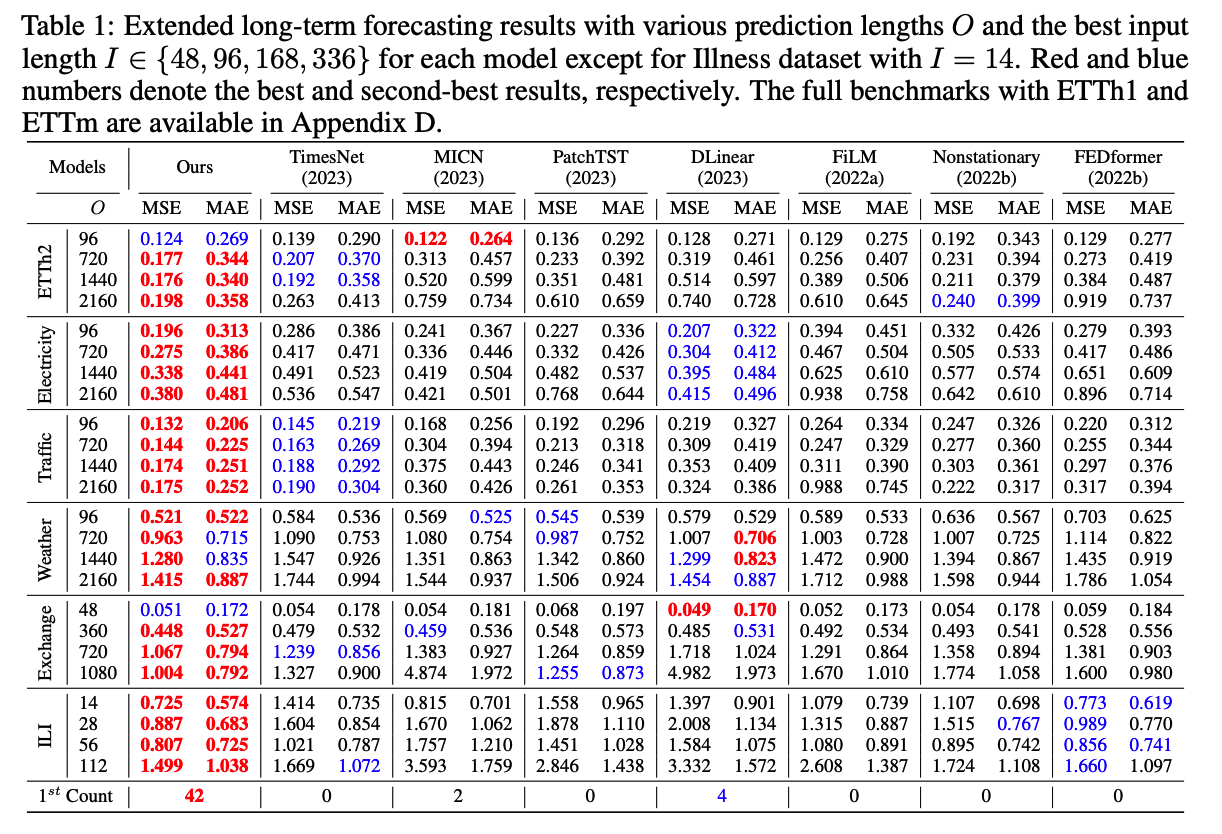
b) Dataset Analysis
Goal : Learn long-term variations
Performance improvements of our model = affected by the magnitude and the number of long-term variations
[Figure 5]

- Various yearly-long business cycles and natural cycles
- ex) ETTh2 and Electricity
- Strong long-term correlations with peaks at several lags repeated multiple times.
- Thus, AutoCOnexhibited significant performance gain s, which are 34% and 11% reduced error compared to the second-best model
- ex) Weather
- Relatively lower correlations outside the windows
- Least improvement with a 3% reduced error
c) Extension to Multivariate TSF

(2) Model Analysis
a) Temporal Locality and Globality: Figure 6(a)
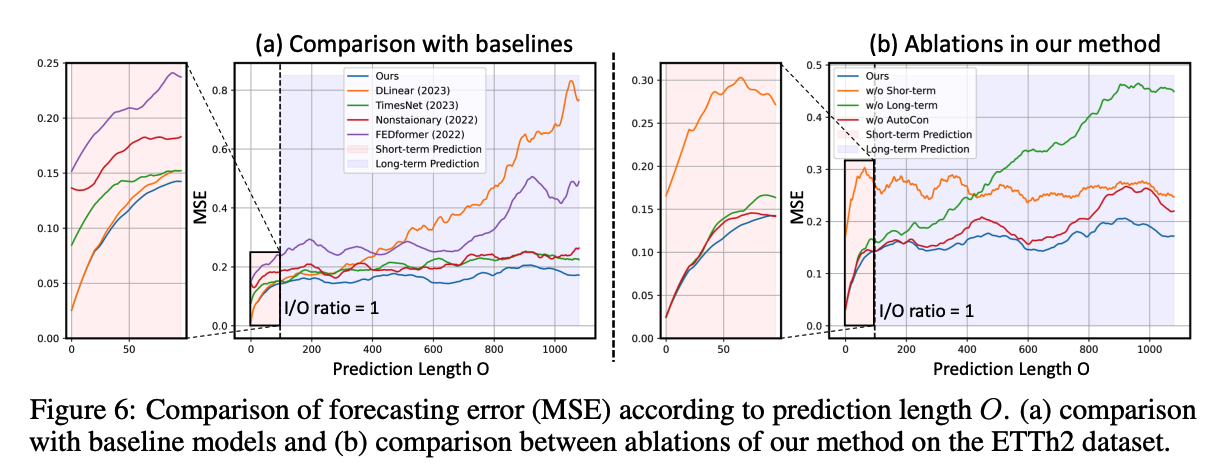
b) Ablation Studies: Figure 6(b), Table 3

(3) Comparison with Representation Learning methods
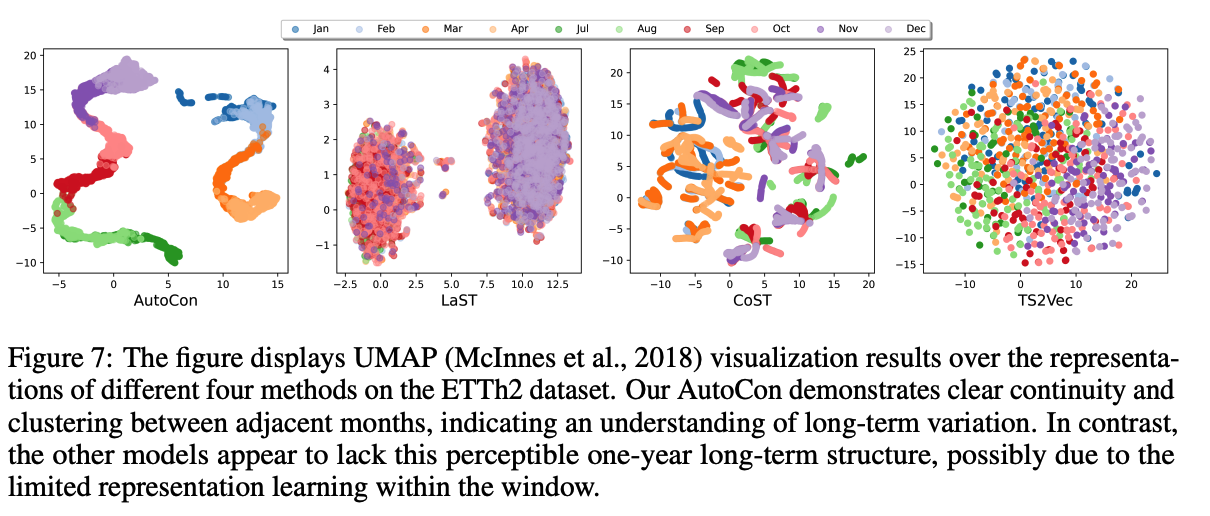
(4) Computational Efficiency Comparison
( Dataset: ETT dataset )
-
w/o AutoCon : computational times of 31.1 ms/iter
( second best after the linear models )
- w/o AutoCon : does not increase significantly (33.2 ms/iter)
- \(\because\) No augmentation process and the autocorrelation calculation occurs only once during the entire training.
- Transformer-based models (Nonstationary 365.7 ms/iter)
- state-of-the-art CNN-based models (TimesNet 466.1 ms/iter)
